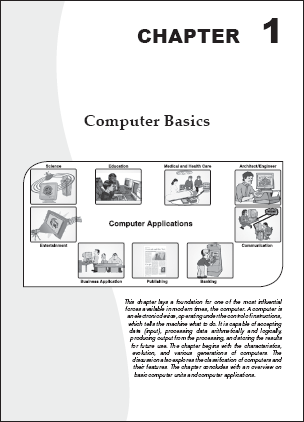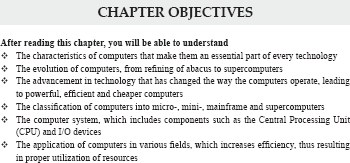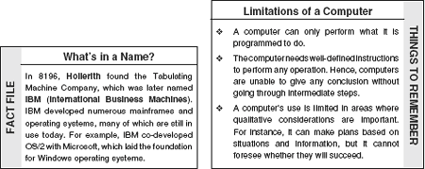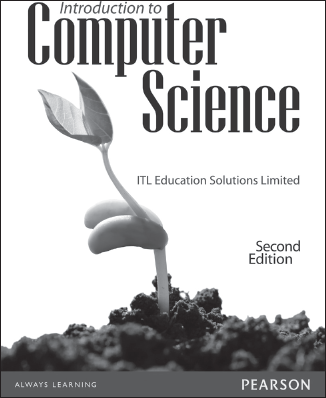Preface
The world today is witnessing a new kind of revolution—the Information Revolution—ushered in by tchnology. This revolution is far more sweeping than any other revolution in history in its reach and influence, bringing fundamental changes in all aspects of our life.
Information technology (IT) is the engine used to drive useful information systems. This includes computers, software, Internet/intranet and telecommunication systems. IT provides the means for collecting, storing, encoding, processing, analyzing, transmitting, receiving and printing text, audio or video information.
In the present context, IT is not merely the matter of machines and microchips. In fact, now it regulates all aspects of our lives including how we live, how we work, how we communicate, how we relax, how we travel and how we talk. This universal applicability of IT has made it the most important part of all technological curricula throughout the world. The future of IT promises to be more dynamic. Researches in the field of processor performance, chip miniaturization, artificial intelligence (AI) and other areas are setting up new standards every day. Keeping pace with these changing trends and to meet the requirements of modern curricula, the book has been revised.
The revised edition of Introduction to Information Technology has become more comprehensive with several enhancements. Similar to its previous edition, it also dwells on fundamentals that one must learn in order to pursue virtually any endeavor in the IT field. In addition, it covers some latest trends of IT such as Internet protocol television (IPTV), radio frequency identification (RFID), brain computer interface (BCI), blogging and many more. The main objective is to teach IT concepts to people who will be the end users and to those who need some insight into IT. Our approach is to strike a balance between the why and the how of IT use.
This book trains students with the concepts needed to lay a solid foundation for joining this exciting field. It is important to learn the fundamentals so that one has the tools necessary to learn emerging technologies as they become more common. In simple words, reading this book will benefit anyone who wishes to arm themselves with substantive computer skills.
Our long experience of training computer professionals has enabled us to come out with a book that is reader friendly and teaches important concepts in an easy-to-understand format. The treatment of the subject matter is kept quite simple and concepts are explained with the help of examples and illustrations. The end result promises to be an outstanding learning material for all those who are interested in the body of knowledge we call Information Technology.
FOCUS
The experts and educators are faced with the challenging task of developing courses to teach emerging computer science concepts in college and university curricula. Such an undertaking requires adequate literature and explanation of key computer concepts at an introductory level. The computer textbooks used in colleges are either too advanced that they have less instructional value or are too focused on describing particular tools such as word processing, multimedia and spreadsheet applications. Some start at a very high level of complexity because of which students get lost in details before they grasp the fundamental concepts, while others cover material without cohesion between topics. Keeping all this in mind, this book has been developed to present the fundamentals of IT in an easily understandable manner. The book has been designed to assist the reader to grasp the fundamentals of IT.
UNIQUE FEATURES
- The book is written in a clear, concise and lucid manner and is student friendly.
- Independent thinking and research on the subject imparts a practitioner's perspective to it and makes the text thoroughly enjoyable.
- Emphasis is laid on practical application of theory. All ideas and concepts are presented with clear examples.
- Historical perspective describes components, systems or events from the past.
- The text is well structured and well supported with suitable diagrams.
- Fact files and things-to-remember boxes provide a snapshot of the subject covered.
- Major applications of IT and their strategic implications for business and social activities are described.
- Inter-chapter dependencies are kept to a minimum.
- Chapter objectives, a summary at the end of each chapter and review questions are also present.
- A comprehensive index is presented at the end of the book for quick access to the topics.
KEY ADDITIONS TO THE SECOND EDITION
Although several enhancements have been made to the text, we are highlighting the key additions to this new edition here:
- Some new secondary storage devices such as pen drive, memory stick, blue-ray disk and external hard disk have been added to Chapter 3.
- Some more input/output devices such as trackpad, webcam, projector, electronic whiteboard and headphone and headset have been included in Chapter 4.
- The basic Windows accessories including Calculator, Notepad and Paint have been discussed in Chapter 6.
- Two new chapters providing an overview of Microsoft Windows 7 and Microsoft Office 2007 have been added.
- The concepts of word processing, spreadsheets, PowerPoint presentations and relational database are now discussed using Microsoft Office 2003.
- Chapter 23, Current and Future Trends in IT, has been thoroughly revised to include the technologies currently in use such as RFID, IPTV and BCI as well as some imminent technologies such as the concept of Pen PC, Napkin PC, Roll top computer, B-membrane PC and USB memory stick.
TARGET AUDIENCE
- Primary usage as a textbook for students of PGDCA, BCA, BE, BIT, BSc (IT), BTech, MSc (IT) and MCA courses offered by computer science, computer engineering and IT departments in colleges and universities.
- Also useful as a textual resource in vocational training courses offered by many colleges.
- As a self-study guide for non-computer science professionals.
This book serves the requirements of both students and professionals. In fact, it is aimed at all those people who wish to know all about IT fundamentals.
CHAPTER ORGANIZATION
- Chapter 1 provides an overview of the history of computers and basic digital computer concepts.
- Chapter 2 describes how computations are carried out using arithmetic and logic units, registers and control unit.
- Chapter 3 introduces the reader to computer memory including an in-depth understanding of RAM and ROM. The chapter also describes the secondary storage and its types such as magnetic tapes, magnetic disks, optical disks and memory sticks.
- Chapter 4 describes how a computer interacts with input devices such as keyboard and mouse and with the output devices such as printer, monitor and projector.
- Chapter 5 provides an overview of the operating system along with its types and functions.
- Chapter 6 discusses Microsoft's Windows XP along with its in-built tools and features.
- Chapter 7 provides an overview of the latest version of Windows, that is, Microsoft Windows 7.
- Chapter 8 introduces the reader to IT. The chapter discusses the impact of IT in various areas such as business, defense, public sector and media.
- Chapter 9 provides a broad grounding in multimedia.
- Chapter 10 deals essentially with programming and various programming tools such as algorithm, flowchart and pseudocode. The chapter also discusses commonly used programming languages.
- Chapter 11 provides the fundamentals of computer software and its relationship with the hardware in building up a fully functional computer system.
- Chapter 12 discusses the user interface of Microsoft Office 2007. It also discusses enhanced and new features of its core applications including Microsoft Office Word, Excel, Access and PowerPoint.
- Chapter 13 provides a foundation to harness the power of word processing using Microsoft Office Word 2003.
- Chapter 14 provides a base for the reader to harness the power of a spreadsheet program using Microsoft Office Excel 2003.
- Chapter 15 provides a foundation for the reader to harness the power of creating presentations using Microsoft Office PowerPoint 2003.
- Chapter 16 deals with data communication and computer network along with important concepts like transmission modes, network topologies and the OSI reference model.
- Chapter 17 helps in building an understanding of the basic Internet structure and processes.
- Chapter 18 introduces the reader to the different Internet tools such as browsing, searching and sending and receiving e-mails.
- Chapter 19 provides a foundation in the field of computer security. Computer security is applied to the computer systems to ensure the availability, integrity and confidentiality of information against unwanted access, damage and modification.
- Chapter 20 provides the basic understanding of database management system along with its components and architecture.
- Chapter 21 introduces the reader to structured query language (SQL), which is a standard computer language for accessing and manipulating databases.
- Chapter 22 provides a foundation to harness the power of databases using Microsoft Office Access 2003.
- Chapter 23 provides a base for the reader to harness the power of IT in areas such as e-commerce, wireless applications and communication. It also discusses some new technologies that have been proposed for the future.
- Chapter 24 introduces the reader to the fundamentals of AI.
OUTSTANDING PEDAGOGICAL FEATURES
The outstanding pedagogical features in the book have been designed to plan a clear and well-targeted route map for students’ understanding and knowledge enhancement. These features are:
- Chapter Openers
Every chapter begins with a pictorial/ diagrammatic presentation and a nutshell description of what lies ahead in the chapter.

- Chapter Objectives
An exhaustive list of chapter objectives clearly specifies learning outcomes.

- Fact File and Things-to-Remember Box
Regular fact files and things-to-remember boxes, which provide a snapshot of the subject covered, enable students to know facts about a particular section and help them to quickly revise the concepts.

- Further Reading
For more details on the following chapters, refer to the book Introduction to Computer Science, second edition, published by Pearson Education.
- Chapter 1 Computer Basics
- Chapter 2 Computer Organization and Architecture
- Chapter 3 Computer Memory and Storage
- Chapter 4 Input Output Media
- Chapter 5 Operating System
- Chapter 9 Multimedia Essentials
- Chapter 10 Computer Programming and Languages
- Chapter 11 Computer Software
- Chapter 16 Data Communications and Computer Networks
- Chapter 17 The Internet
- Chapter 20 Database Fundamentals
- Exercises
End-of-chapter exercises with a set of objective and descriptive questions aim to develop wide and varied skill sets in the students.

INSTRUCTOR'S RESOURCE CENTER
A PowerPoint presentation is available to aid instructors in teaching the subject. The presentation is accessible from www.pearsoned.co.in/ITLEducationSolutionsLimited.
FEEDBACK
For any suggestions and comments about this book, please feel free to send an e-mail to [email protected].
Hope you enjoy reading this book as much as we have enjoyed writing it.
